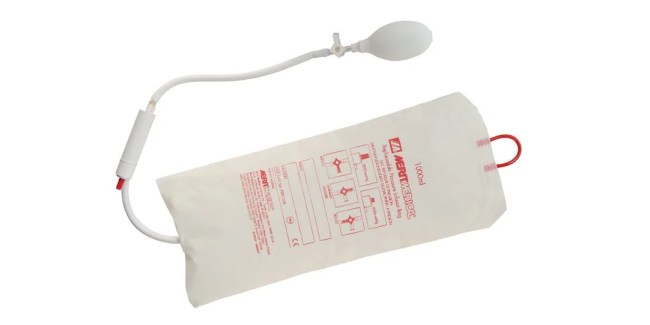Trick of Trade: Alternative to a Pressure Bag for IV Fluids
 You have a severely dehydrated patient with a peripheral IV line, requiring urgent fluid resuscitation. However, the crystalloid fluids are not flowing freely. Multiple attempts were made to place this line with the latest having a flash of blood return and a smoothly flowing saline flush. You can not seem to find your pressure infusion cuff to squeeze the IV bag and accelerate fluid administration.
You have a severely dehydrated patient with a peripheral IV line, requiring urgent fluid resuscitation. However, the crystalloid fluids are not flowing freely. Multiple attempts were made to place this line with the latest having a flash of blood return and a smoothly flowing saline flush. You can not seem to find your pressure infusion cuff to squeeze the IV bag and accelerate fluid administration.
Trick of the Trade: Manually provide positive pressure fluids using a 3-way stopcock
- Attach a 3-way stopcock between the angiocatheter and IV tubing.
- In the unused port, attach a 10 or 20 cc syringe.
- Fill the syringe with fluids from the IV bag (turn off flow to the angiocatheter using the stopcock)

- Rotate the stopcock 180-degrees and push the syringe fluid into the angiocatheter.

- Repeat this process several times.
- After manually pushing 100-200 cc of fluid through the line, turn the stopcock to shut off the syringe port. The fluids should flow more rapidly with gravity alone.
Word of Caution: Syringe Fluid Contaminant
Thanks to Twitter feedback from @cpatrick_89, be careful of introducing bacteria when attaching these pieces to the IV tubing, based on an in vitro study. Wearing gloves helped reduce bacterial contamination [1].
Note that conventional pressure bags may not be readily available in emergency departments and could blow the line you worked hard to secure. This “gentle pressure” technique allows the clinician to gauge how much positive pressure to administer to minimize the risk of fluid extravasation.
Interested in Other Tricks of the Trade?
Reference
- Kawakami Y, Tagami T. Pumping infusions with a syringe may cause contamination of the fluid in the syringe. Sci Rep. 2021;11(1):15421. Published 2021 Jul 29. doi:10.1038/s41598-021-94740-1













